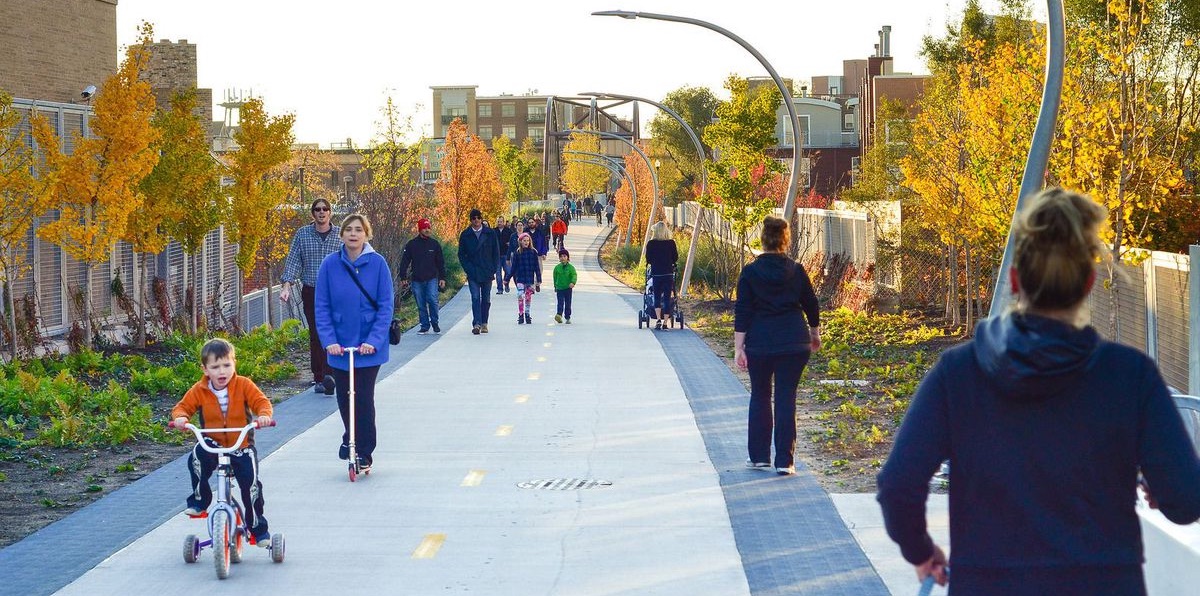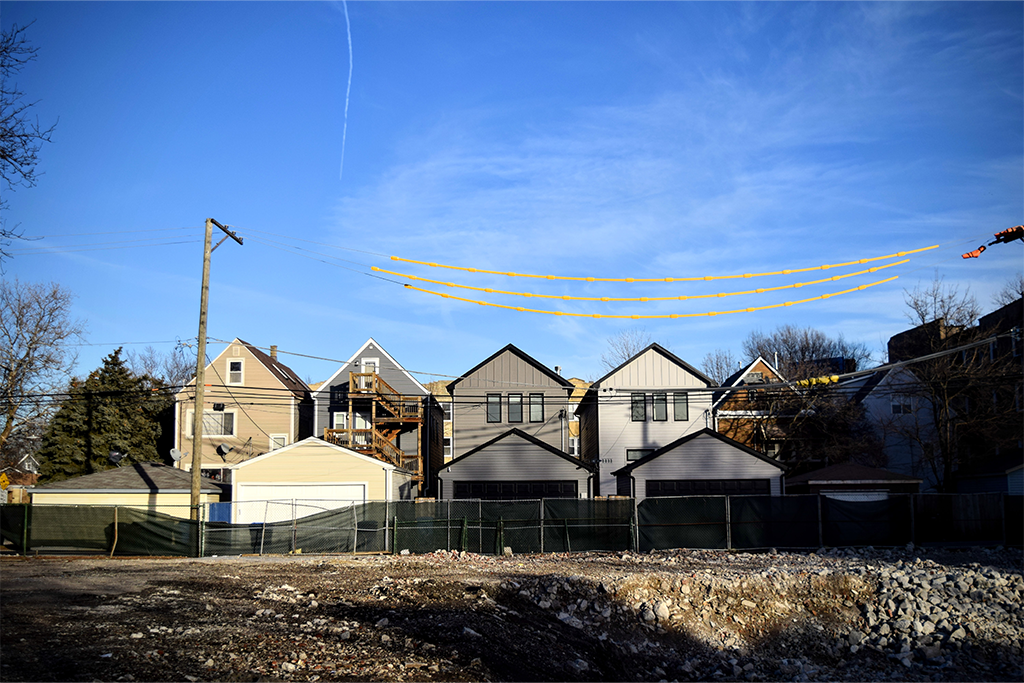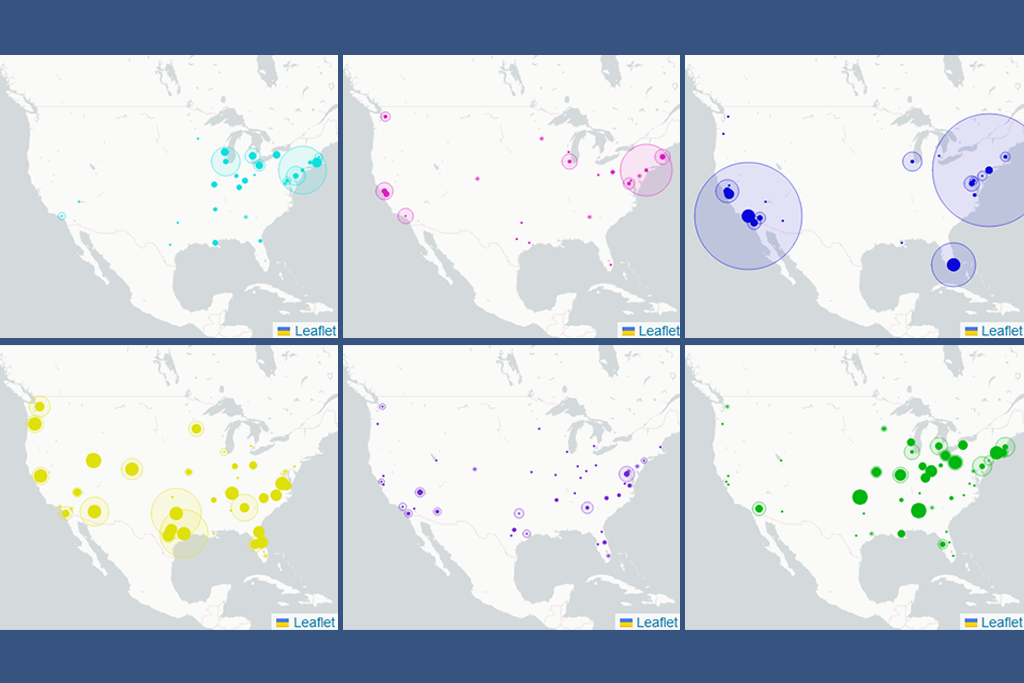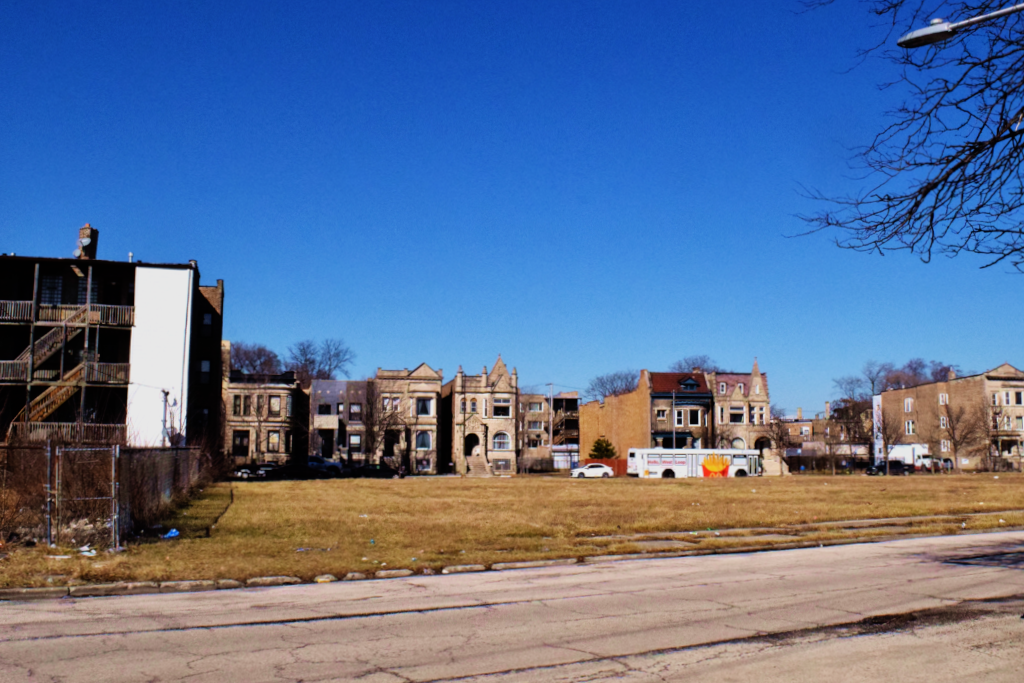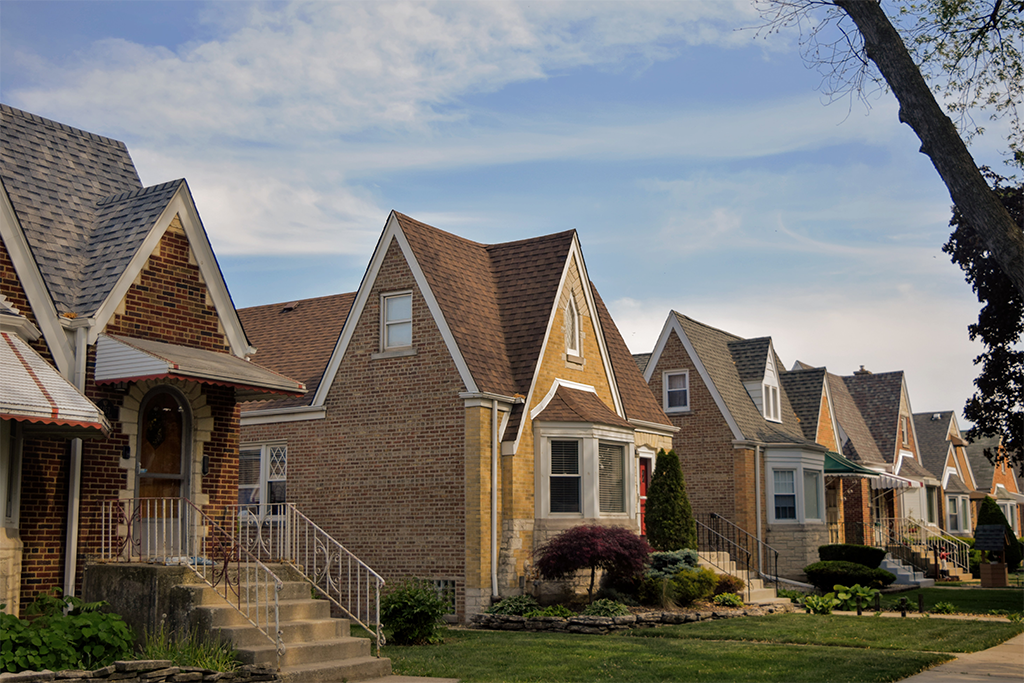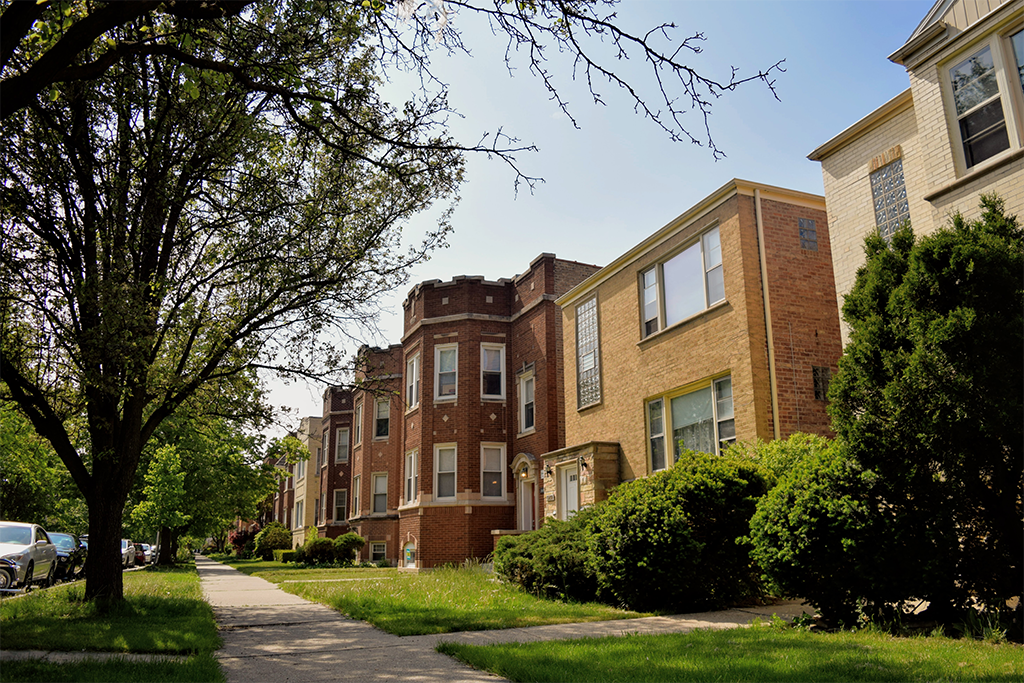Image source: Flickr Creative Commons / Matthew Wilder
This report goes “under the hood” of our Mapping Displacement Pressure in Chicago project data to highlight how house prices are changing in the neighborhoods around The 606 linear park system and highlights a potential strategy to preserve affordability in surrounding communities. It finds that rising prices have largely eroded the stock of lower-cost homes near the trail system, particularly 2 to 4 flats that tend to make up a neighborhood's unsubsidized affordable housing supply. In moderate-cost neighborhoods with rising prices, interventions are needed to mitigate displacement pressure. Among these solutions is helping mission-driven developers and others acquire a portion of this stock and preserve it as affordable. Data show that there is still a potential inventory to feed this type of policy solution nearby, but the window to act is closing as prices increase and the supply disappears.
Key Findings:
- Prices for 1 to 4 unit buildings in the vulnerable portions of the western half of The 606 have increased by nearly 344 percent since 2012. Whereas the average home in 2012 sold for 30 percent less than the city average, the average 1 to 4 unit building sold for double the average Chicago home in 2018.
- In this area, rising prices have hit 2 to 4 unit buildings particularly hard. The median sales price for a 2 to 4 flat was $97,000 in 2012, jumping to $340,000 in 2016 and $462,000 by 2018.
- Behind these trends is a shift from a housing market that used to be dominated by 2 to 4 sales selling for less than $300,000; 84.4 percent of properties sold for less than $300,000 in 2012; 35.8 percent sold for less than $300,000 in 2016; and 17.6 percent sold for less than $300,000 in 2018.
- As this relatively lower-cost stock disappears, opportunities for robust interventions to preserve affordability near The 606 are also fading. However, beyond the small geography of The 606, in moderate-cost Hermosa, Humboldt Park, and west Logan Square prices for 2 to 4 unit buildings are relatively more affordable and finding properties that sell for less than $300,000 is more common.
Background
Since 2017, the Institute for Housing Studies (IHS) has released Mapping Displacement Pressure in Chicago, unique data and analysis updated annually to help local practitioners and policymakers develop and implement proactive interventions to preserve housing market affordability in different neighborhood contexts. The Mapping Displacement Pressure in Chicago project’s mission stemmed from IHS’s 2016 analysis of The 606’s impact on the surrounding neighborhoods’ housing markets. IHS research found that house prices rose along the trail after the project broke ground and that these increases were far more dramatic in the more affordable, predominantly lower- and moderate-income western portions of the trail - driven by a 22.7 percent price premium for properties nearest to The 606.
These findings aligned with growing concerns of lost affordability and displacement pressure in neighborhoods along the western part of the trail and pointed to the need for analysis to support proactive affordable housing strategies in rising cost communities across the city. IHS responded by creating its Mapping Displacement Pressure in Chicago project, combining information on economic and demographic vulnerability of neighborhood residents with data on current and changing housing market conditions to create a leading data indicator that serves as 1) an early warning sign for changing conditions potentially impacting housing affordability for vulnerable populations, 2) a lens for understanding the variation in housing markets across Chicago, and 3) a resource for important, in-depth housing market context for areas where planned investment may impact housing demand and affordability.
In this report, we revisit neighborhoods around The 606 using our updated Mapping Displacement Pressure in Chicago data along with more granular property sales data to examine shifts in the composition of 1 to 4 unit sales in the census tracts adjacent to the trail system*. This research builds on the type of analysis IHS produces as technical assistance for its non-profit partners to inform their work on the ground. It finds that there have been fairly dramatic shifts in house prices in census tracts adjacent to the trail system, particularly a loss of lower-cost inventory of 2 to 4 unit buildings that are critical to the city’s stock of unsubsidized affordable housing. Despite these shifts, data show that there are potential opportunities for preserving housing affordability that may still exist in small numbers in the western portions of the trail and in greater quantities in moderate-cost neighborhoods nearby.
Three Years of Mapping Displacement Pressure Around The 606
IHS’s earlier analysis of housing market changes in the neighborhoods around the 606 broke out the areas adjacent to the trail into two geographic submarkets, 606 East and 606 West, using Western Avenue as the “mid-point” between the two areas. For this report, we are further refining the analysis by adding in the vulnerability layer important to the Mapping Displacement Pressure analysis (Figure 1):
• 606 East – Higher-cost, high-income areas east of Western Avenue
• 606 West (not vulnerable) – Areas west of Western Avenue that were part of "606 West" in our previous study, but higher incomes mean these areas are “not vulnerable” to displacement in IHS Mapping Displacement Pressure analysis
• 606 West (vulnerable) – Areas of "606 West" in our previous analysis that were predominantly lower- and moderate-income and considered “vulnerable” to displacement in IHS's Mapping Displacement Pressure analysis
Figure 1. Housing Market Type and Resident Vulnerability to Displacement in Census Tracts Adjacent to The 606, 2018
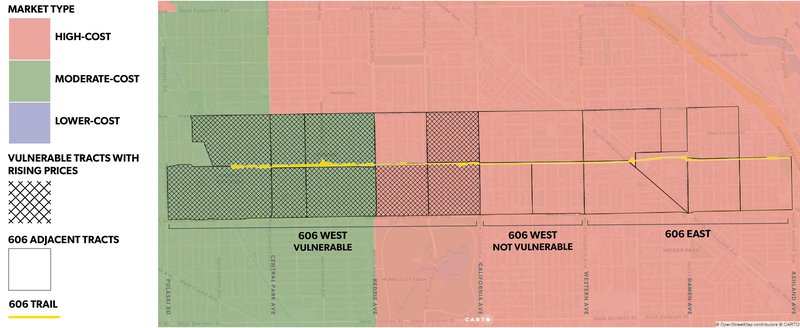
Since 2016, data at the neighborhood-level show a fairly consistent picture of prices in the area surrounding The 606. Census tracts in 606 East and the non-vulnerable portions of 606 West have remained high-cost while tracts in the vulnerable portions of 606 West have oscillated between moderate-cost and high-cost, reflecting the cycle of investment and property flipping activity occurring in these neighborhoods that can create big swings in sales prices year-to-year.
Drilling down to data on median sale prices further illustrates these trends and price patterns. Figure 2 below shows that while median sales prices for the average 1 to 4 unit building (single-family home or a 2 to 4 unit building) in Chicago increased just 5.7 percent between 2016 and 2018, median sales prices in 606 East increased by 16.4 percent between 2016 (the first full year the trail was open and the year of our study) and 2018 – from $825,000 to $960,000. In the census tracts in 606 West that do not have high concentrations of low-income residents and are therefore not flagged as vulnerable by IHS’s methodology, median sales prices for 1 to 4 unit buildings increased by 14.7 percent – from $528,000 in 2016 to $605,500 in 2018.
In the vulnerable census tracts in 606 West where regard for the trail system has long been mixed with concerns that rising prices and new demand for housing from higher-income residents is increasing displacement risk for long-term residents, prices for the average 1 to 4 jumped 24.8 percent between 2016 and 2018. Figure 2 shows that whereas the average 1 to 4 unit property sold for $345,000 in 2016, the average 1 to 4 sold for $430,500 in 2018. Additionally, this area has experienced much more substantial price increases since 2012 than the other areas near The 606 or the city as a whole. For example, Figure 3 shows that between 2012 and 2018, median sales prices in vulnerable 606 West increased 343.8 percent – from $97,000 at the bottom of the market in 2012 to $430,500 in 2018. In 2012, the median sales price in vulnerable 606 West was nearly 30 percent less than the average city property. By 2018, the median sales price increased to nearly double the city average. Over the years, rapidly rising prices near The 606 have prompted recurring efforts by local aldermen to find ways to mitigate changes to the housing stock, rising rents, and overall lost affordability near the trail.
Figure 2. Overall trend in Median Sales Prices for 1 to 4 Unit Properties in Census Tracts Adjacent to The 606, 2012, 2016 and 2018
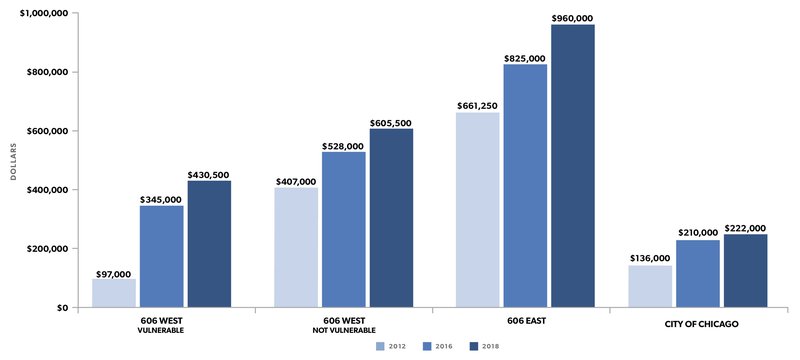
Figure 3. Percent Change Since 2012 in Median Sales Prices in Census Tracts Adjacent to The 606 and the City of Chicago, 2012 to 2018
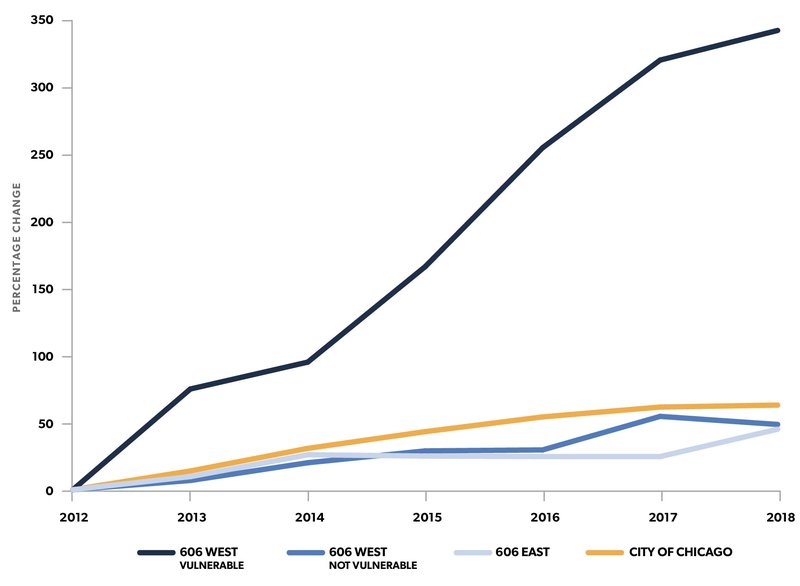
Opportunities to Preserve Relative Affordability
While overall affordability levels mapped by IHS in its Mapping Displacement Pressure in Chicago tool illustrate the general trend in the area, what these trends mean for displacement pressure and particularly the opportunity for preserving any remaining affordability in the market has much to do with the mix of properties selling at different price points as well as the availability of lower-cost 2 to 4's.
Buildings with between 2 and 4 units are a critical component of the city’s affordable housing stock, providing essential, lower-cost housing to renters all over Chicago. These properties are more likely to offer lower rents and provide housing to lower-income households than other types of rental properties, but, in rapidly changing neighborhoods, the affordability of rental units in 2 to 4 unit buildings is threatened, lost to rising rents or conversion to large single-family homes as owners sell and as demand shifts to higher-income households in strong-market neighborhoods. The loss of these affordable units impacts the housing supply and the affordability of the housing stock and increases displacement pressure for vulnerable households.
In high- or moderate-cost areas with rising prices, strategies to support the preservation of the naturally occurring affordable housing stock, such as 2 to 4 unit properties, are key to preserving neighborhood diversity and mitigating displacement. These strategies include supporting mission-driven investors to proactively acquire 2 to 4’s to keep them affordable.
This type of strategy has proven to be an effective approach in Chicago, where community organizations, mission-driven developers, and community development financial institutions have formed partnerships to acquire 2 to 4 unit properties to keep rental units affordable for the long term. Similarly, a new initiative in west Logan Square and Hermosa hopes to acquire affordable single-family homes and rental buildings to preserve housing affordability in the neighborhood before the window to preserve these units is closed. The City of Chicago also has programs such as the Preservation of Existing Affordable Rental (PEAR) and the Chicago Community Land Trust to support the preservation of affordable units.
Fundamental to the success of these types of programs is the ability to acquire buildings at price points that allow them to remain affordable. In rapidly rising markets, this can be a challenge given higher prices and heavy competition from market-rate investors who have ample cash-on-hand and are able to move quickly. Mission-driven developers typically have limited resources and need to identify properties at an affordable price point. If properties need substantial rehab work, the acquisition price will need to be lower to account for these additional costs and the need to maintain affordability. These types of affordable housing preservation strategies can be a more cost-effective complement to heavily subsidized programs that build new affordable units but may need access to particular financial products and capital to be scalable.
To understand what opportunities may exist to acquire relatively affordable 2 to 4 unit properties, IHS examined the composition of sales in the areas immediately adjacent to The 606 and in the moderate-cost communities just beyond. Figure 4 illustrates that while the recently-sold stock of 2 to 4 unit properties in 606 East and not vulnerable portions of 606 West is fairly homogenously high-cost (96.4 percent and 69.4 percent of 2 to 4 unit properties respectively sold for $500,000 or more), the census tracts in 606 West do still have some relative affordability. In the vulnerable portions of 606 West, 45.1 percent of properties sold for $500,000 or more but a small number, 9 buildings (17.6 percent of 2 to 4’s sold in 2018), had sale prices less than $300,000 in 2018.
Figure 4. 2 to 4 Unit Building Sales Activity in Census Tracts Adjacent to The 606 and the City of Chicago, 2012 to 2018
However, looking beyond the small geography of The 606, median sales prices of 2 to 4 unit properties in the more moderate-cost western portion of Logan Square and in Humboldt Park and Hermosa are selling at relatively more affordable prices. In this broader area, 167 buildings with 2 to 4 units sold for less than $300,000 in 2018 – and 58 of those properties sold for less than $150,000. While the data in Figure 5 show higher levels of affordable inventory in these areas, the analysis shows an increasingly dwindling supply of lower-cost 2 to 4’s, however – especially in western Logan Square. Between 2016 and 2018, the share of 2 to 4's selling for less than $300,000 in Hermosa declined from 70.6 percent to 55.4 percent. In moderate-cost parts of Humboldt Park, this number decreased from 84.3 percent to 73.7 percent, and in moderate-cost Logan Square from 40.4 percent to 24.5 percent.
Figure 5. 2 to 4 Unit Building Sales Activity in the City of Chicago and in Moderate-Cost Census Tracts with Rising Prices and Vulnerable Populations in Hermosa, Humboldt Park, and Logan Square, 2012 to 2018
Although we do not know the condition of these properties, these data show there are still opportunities for mission-driven entities to acquire 2 to 4 unit rental buildings at price points that may allow them to remain affordable, but this inventory is shrinking and the window for this type of intervention is narrowing. In the first half of 2019, for example, this inventory continued to decline. The data in Figure 6 show that the share of 2 to 4 unit buildings sold for less than $300,000 in Hermosa, Humboldt Park, and Logan Square declined by another 5.4, 9.6, and 10.2 percentage points between 2018 and the first half of 2019, respectively. Explore the interactive map below to see how these data look on the ground.
Figure 6. Share of 2 to 4 Unit Building Sales Less than $300,000 in Moderate-Cost Census Tracts with Rising Prices and Vulnerable Populations in Hermosa, Humboldt Park, and Logan Square, 2018 to 1H2019
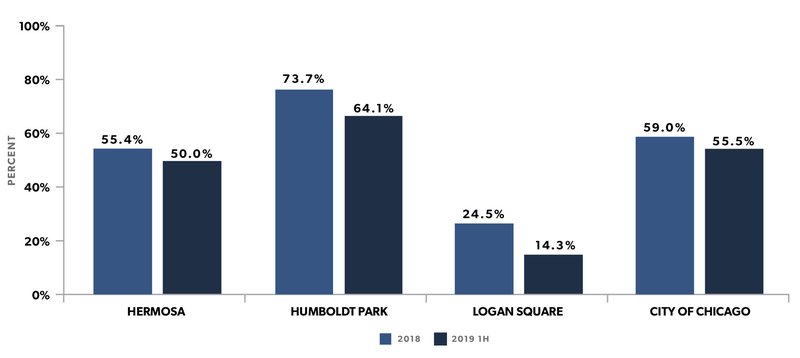
Map 1. 2 to 4 Unit Building Sales Activity in Moderate-Cost Census Tracts with Rising Prices and Vulnerable Populations in Hermosa, Humboldt Park, and Logan Square, 2018 to 1H2019 (Link to Full-Page Map)
What's Next
As part of our annually updated interactive mapping tool, IHS has consistently highlighted three high-profile projects that have either been recently built or are planned: The 606, The El Paseo Trail, and the Obama Presidential Center, to help users understand potential displacement risk in neighborhoods near these projects. Understanding changing displacement pressure highlights the importance that affordable housing plays in ensuring that existing lower-income residents can benefit from new neighborhood investment. Future reports will profile shifts in displacement pressure near the future Obama Presidential Center and in the neighborhoods surrounding the proposed El Paseo Trail.
To keep up-to-date on new analysis and blog posts and information about our work, sign up to receive our emails, follow us on Twitter, like us on Facebook, or follow us on LinkedIn.
*All data are from the IHS Data Clearinghouse - sources used for this report include data from the Cook County Recorder of Deeds and the Cook County Assessor.
